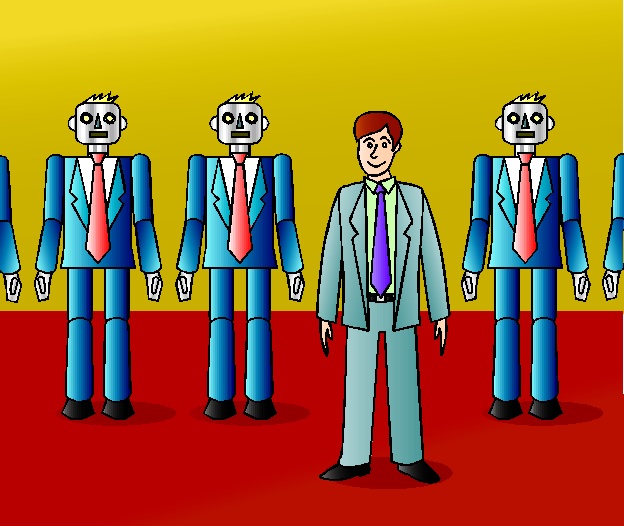
What do you do when you’re a brand without a personality? These days, you make one up.
When you think of Netflix, MTV, and HBO, no lead person or celebrity comes to mind. That’s because they are platforms and channels that offer all sorts of programming.
But there’s no star of the channel – like a high-profile morning team or an influential talk host.
All three are highly successful, offering attractive content to millions of consumers. But they have no personality, persona, or spokesperson to interact with fans. Now, when you turn on your TV, that’s probably not what you’re looking for.
But when you’re on Facebook or Twitter, interactivity with a faceless channel isn’t exactly stimulating or engaging. In fact, when you think about these types of brands on social media, they tend to simply promote themselves, rather than mix it up with viewers and fans. After all, who wants to interact with an impersonal brand?
GOOD MORNING, BEAUTIFUL WORLD.
I’m very excited to share that ROMA has been nominated for 10 Academy Awards, including Best Picture, Best Director – @AlfonsoCuaron, Best Actress – @YalitzaAparicio, Best Supporting Actress – @MarDeTavira, and Best Original Screenplay! pic.twitter.com/cHPJYBQq7o
— Netflix Film (@NetflixFilm) January 22, 2019
Perhaps that why the aforementioned TV networks (or in Netflix’s case, streaming platform) have strategically modified their social media personalities. They’re now speaking in first person – liberally using “I” in tweets and posts – even though there is no HBO person, MTV dude, or Netflix mom. And according to The Ringer’s Alyssa Bereznak, who’s spotted the trend, it’s working. These brands try to come off like an authentic social media person – posting memes, using emojis and stickers, that come off as snarky, sassy, irreverent – just like how real people are using social media.
By socially communicating in the first person, there’s greater intimacy, as well as the chance to offer up opinions about shows, pop culture, and anything reflective of the channel or brand. In the same way an actor tries to occupy a character in a play, film, or TV show, the behind-the-scenes people for these brands create a definitive persona in the social space.
And we’re not just talking media brands. Steak-umm – yes, those steaks in the frozen food aisle – has become famous for its wild and crazy Twitter feed with 50,000 followers:
ATTN Steak-Umm cult followers
here are the guidelines to our new world order:– bless everyone even our idiot college intern steve
– no hot pockets
– saying “is it steak? umm..” may land you in the dungeon
– beef memes are currency
– RT everything so I can keep my job— Steak-umm (@steak_umm) January 18, 2018
Bereznak quotes Nathan Allebach, the creative force behind Steak-umm’s personal Twitter account:
“When you’re trying to actually build a brand from the ground up, it’s a lot easier to do that when you’re speaking in first person because people who are interacting, connecting with the brand itself, they feel connected to the people or the person behind it.
“So we found early on that the best way to go about it was just to humanize and be as real as we could, break down the fourth wall often as we could and make people feel like this wasn’t some vanilla corporate strategy.”
If that sounds a lot like how broadcasters grow radio stations – getting fans to connect and engage with on-air personalities to build loyalty and sense of belonging.
In many ways, it’s the way we coach air talent – to visualize speaking to one person while staring at hunk of glass when they open the mic. The best jocks, teams, and talk show hot shots are the ones who sound the most real, the most authentic – that is, the most like us.
As Steak-ummm’s Allebach knows, when you’re stuck with a lifeless, bland food brand, it’s a challenge to breathe life into it.
But when you’re a radio station, the on-air personality is your cash crop. It’s what sets you apart from all those other media entities – Pandora, Spotify, Netflix, Apple, Facebook, Google, and all the rest.
Or at least it should be. Because when you think of many of the brands broadcasters now find in their crosshairs – or shorts – they almost all lack that  personal touch, that ability to entertain, empathize, and emote.
personal touch, that ability to entertain, empathize, and emote.
At CES, we’ve become used to seeing legions of robots, trying hard to look more and more human. They have cute names, and some companies have gone so far as to hire animators from companies like Pixar to bring a sense of dimension and personality to their droids and bots.
Similarly, the new voices that occupy our homes and soon, our cars – Alexa, Siri, Bixby, and the others – all utilize human names. And increasingly, their software and AI developing brains are being engineered to take on more human traits.
We know we’re not speaking with a human when we ask Alexa a question. But when we’re talking about the now-famous Amazon voice, we can’t help but referring to it with personal pronouns like “her” and “she.” It doesn’t take much to convince consumers they’re speaking to a virtual voice made to sound like a carbon-based lifeform, as Mr. Spock referred to humans.
The Google Assistant may not have a name, but it’s certainly being programmed to sound like someone you know, speaking more and more with human cadences and traits. The video below featuring their CEO Sundar Pichai, illustrates how any brand – be it a restaurant, telecommunication company, or doctor’s office – can come off as more authentic by mimicking a real person.
https://www.youtube.com/watch?v=2V6NHKmfnW0
But when one of your brand strengths is your people, you have a true advantage over your competition. You don’t have to mimic a human. In the air studio, it doesn’t get more real than the people on the air.
In this competitive media environment, research maven, Bill Moyes, would refer to radio’s personality advantage as a “steel sword” – a difference-maker that matters very much to broadcast radio. That’s what all these other brands, chat bots, and voice assistants are all chasing.
And it’s why MTV – once a channel with well-known, cute, hip VJs – has worked so hard the past five years to breathe humanity into their social media persona. Their CMO, Jacqueline Parkes, explains that a key to pulling off a great personality relationship is to speak to fans – as she describes, “being your friend who knows everything about the topics that you care most about.”
Ryan Reynolds in an upcoming rom-com???? What we deserve! https://t.co/2Npl4p9WMg
— MTV (@MTV) January 30, 2019
When I think of some of radio’s best-known stars – names like Ken Calvert, Bob Stroud, Debbi Calton, Ann Delisi, Bob Keller, Tony Magoo, Dave Kane, Steve Slaton, and so many others – their “secret sauce” is connecting with fans on the most intimate of levels in their local markets. When Jim Ladd would say, “We’re both listening to KMET,” he sounded like your best friend – a guy with an amazing album library who could pick your favorite music and remind you why you loved it so much.
Note that none of these radio personalities are “morning monsters” – they are all what we call “daypart jocks,” often with precious little time to make that fan connection. In Ladd’s case, his best work – his strongest connections – came during the evening hours, when the lights in the studio were low. In an interview a few years ago, he described his vision of what makes “great radio.”
“It should be personal, you know, it should be…the best radio, it should be something that connects with people on a personal level whether it’s through the music or the spoken word…”
Local broadcast radio can provide that one-to-one connection that many of these consumer and media brands are striving to achieve when a consumer is sitting in front of her computer or holding his smartphone. For radio, it’s the car – that intimate sanctum where many of us spend our precious time – is the best setting where talented, knowing radio personalities make their strongest connections with listeners.
Sounding like a PD at a jock meeting, Parkes explains how MTV has found its social voice by doing the equivalent of a Vulcan mind-meld with the channel’s most rabid viewers:
“We stay fully immersed in the communities of interest that matter most to our fans, and genuinely live and breathe these topics as fans first. If you’re not a legitimate fan and understand how that fandom communicates, you’ll immediately get called out for a lack of authenticity.”
And that means connecting with fans in their preferred spaces – often social media. More than a decade after the debuts of Facebook and Twitter, radio brands still struggle to find their social media voice. And managers often struggle making the case that a strong social presence can be as important as the words that flow when the mic opens.
It’s about fans first.
That should be every radio station’s mantra, as the engineers, software technologists, and technocrats work so hard to sound real.
It’s the key to great social media interaction as well as great radio.
- Like A Pair Of Old Jeans - April 2, 2025
- What’s Fair Is Fair - April 1, 2025
- What’s On Your Bucket List? - March 31, 2025




I read today’s blog with much interest … and much skepticism.
A wise radio pro once said to me, “When I listen to a station in a given market, and have no idea what they’re talking about, is when I know I’m listening to the top station in the market”
Personalities are what drive a station’s success – true. But in the interest of cost savings, there’s too much sacrifice of live local talent talking about local events important to the audience. Satellite formats, and hence generic content that works in Everywhere USA, coupled with “corporate contesting” that is not really guaranteed to be locally awarded, diminishes true local impact … in my opinion.
The state of the economy and/or distribution of ad dollars certainly takes some blame. More digital media ad money takes away from broadcast ad dollars.
Keep up with the great thought-provoking blogs.
Appreciate it, Jay. I hope the point got across that personalities should be numero uno for radio – in spite of the cost-savings derived by voice tracking, syndication, etc. Yes, there’s a place for everything, but failing to establish a station persona – hopefully, a local one – will cost radio in the long run.
Reminds me of what legendary programmer/record guy Richard Lippincott (AKA Dave Denver) told me after an aircheck session at WADY/The Lady (Radio for Singles Only—and wasn’t that format a trip) im MIami. “You know it’s a damn shame that DJ’s spend their first 5-10 years learning to talk like a disk jockey and then the next decade or so trying to relearn how to speak like a human being.” Truth out….
Brilliant. And ture. Thanks, John.